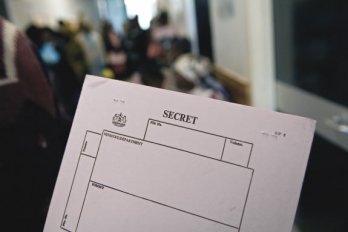mulaittivu—Shortly after the tsunami demolished much of the coast, beneath the shade of coconut trees, Regita collects palmyra leaves from the forest floor to stoke the cooking fire. Her face is heavily lined, her dark eyes hard. But it’s the black hair, cut harshly above her shoulders, that singles her out from the other children and young women under the protection of the Catholic relief camp. Only girls with severe head lice or soldiers in the Liberation Tigers of Tamil Eelam wear their hair so short. Regita’s eyes say soldier.
The thick jungles of the Jaffna peninsula in northern Sri Lanka are home to the Tamil Tigers, a resistance army that has fought the Sinhalese government for over twenty years to establish an independent state. I am deep inside Tiger territory as a guest of the Holy Family Convent, founded in the nineteenth century by Irish missionaries. A nurse has invited me here to run arts programs for tsunami-orphaned children. I’d watched footage of the watery chaos on television, but had I known I’d be working close to where the tsunami struck I might have hesitated since my greatest fear is drowning. I’d also had no idea that I would be allowed into Tiger territory, where few Westerners have trodden, and where the Sri Lankan government was accused of offering little relief funding after the wave hit. The Tigers were seizing on the void to recruit children from the relief camps, trying to replace hundreds, possibly thousands, of soldiers they’d lost to the tsunami.
My host was Sister Anna, a Tamil nun in her mid-forties who had earned the rebel army’s trust. She accompanied me to Tiger headquarters in the city of Jaffna, where my visit was officially sanctioned by a handsome Tiger commander who was missing his right leg. Before stamping my papers, he stressed to me that his forces are not terrorists—a difficult claim to accept given that the Tigers have long targeted civilians and have committed more suicide-bomb attacks than any other militarized organization. Later, I asked Sister Anna about rumours that the eldest child of every Tamil family must join the Tigers. “This is true,” she replied. “We have all lost brothers to the war. [But] if they were terrorists, do you think the Church would support them?”
Two months after the flooding, saris are still wrapped around trees in the coastal village of Mulaittivu. The scars on their trunks show the height of the wave to have been twenty-seven metres. Surveying the shoreline, Sister Anna points to a fallen tree and says it arrived the day after the tsunami with the body of a man tied to it. Then she approaches the water’s edge. “The bodies of children, men, and women lined the beach. I knew many of them.”
There are many more horror stories to tell, but a popular tale in camp is of a perceived miracle. Just days before the tsunami, one of the village priests noticed that “mother ocean” was behaving strangely. As a precaution, he decided to move the St. Stephen’s Day mass five kilometres inland, which probably saved the lives of over 200 of the faithful. The service commenced at 9:15 a.m., almost exactly when the first wave crashed. After mass, the group returned to what was left of the village. Four thousand of its 24,000 souls had been “taken by the water” in five minutes, including 200 of the 300 children in primary school.
Survivors inhabit semi-destroyed buildings or tents pitched inland, and there is little privacy to grieve. One young man, Kumar, weeps openly. His wife, daughter, son, and thirty-nine-day-old baby are gone. “Why should I go on?”
One evening a local priest invites our group of Irish nurses for dinner. After the meal he gathers us in front of a small television and shows a Tamil Tiger video promoting suicide bombings. We watch as a half dozen fit young soldiers scramble over an obstacle course. Their mock assignment: blow up a government helicopter. In one sequence, families cheerfully wave goodbye to their sons, who set off to stalk their targets. Then explosions. Then chaos. The next shot is a candlelit shrine. The soldiers have now become “martyrs,” and tears are shed by loved ones. The priest patiently explains that the tears are of pride not sorrow. The disparity between the nurturing these priests and nuns provide and the violence they seem to support is difficult to reconcile.
Back at the camp, the children seem oblivious to the war and the destruction of their family lives caused by the tsunami. They throw their energy into art workshops, often painting well past sunset. When night falls, Regita tenderly helps the younger children, all orphaned, to their beds. Late at night, once all is quiet, a nun explains Regita’s delicate situation. After completing secondary school, Regita volunteered to join the Freedom Birds, the female faction of the Tigers, which is said to be more vicious than the male units. Then, in late December, as the fragile peace between the Sinhalese government and the Tigers was fast dissolving, Regita became frightened and fled, forsaking her soldier’s life. Usually Tigers hunt down deserters and punish or kill them.
But then the tsunami came, and the Tigers assumed that Regita had been taken by the water. Instead, she found refuge in the safety of a relief camp, where she is camouflaged as a volunteer to the orphans. To reunite with her family would be too dangerous. The nuns, despite their sympathy for the Tigers, are primarily humane and, recognizing the plight of this young woman, they protect her from being discovered. By now, near the first anniversary of the tsunami, Regita’s hair will have grown long. With luck, the Sisters have moved her further south to begin a new life as a civilian. For Regita, the tsunami was a blessing.




